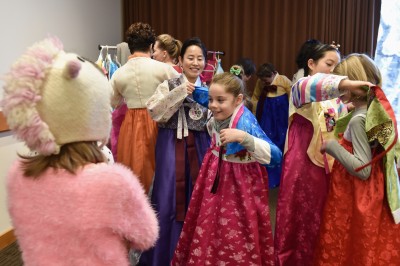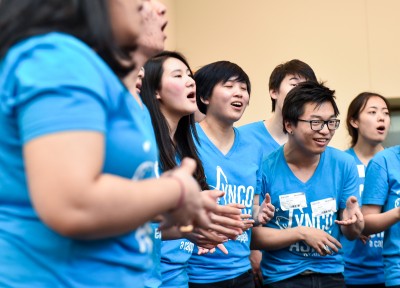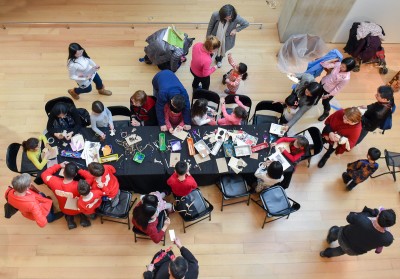
The normally quiet rotunda of the Museum of Fine Arts reverberated with hundreds of voices Saturday as guests welcomed in the Lunar New Year.
The celebration was held throughout the museum, involving traditional crafts, demonstrations such as the Korean New Year greeting ceremony Sae-bae, performances and special exhibits for all ages.
One of the day’s most popular events was the customary Chinese Lion Dance, performed by Gund Kwok, New England’s only all-female Lion and Dragon Dance Group. The children of the Chinese Culture Connection also performed a Lion Dance in addition to their Chinese Gong-Fu martial arts demonstration.
Syncopasian, a Massachusetts Institute of Technology a cappella group, performed East Asian-originated songs upstairs next to the Linde Family Wing for Contemporary Art. The group, which was established in 2008, won the top collegiate prize during the 2015 season of WGBH’s vocal competition “Sing That Thing.”
“We specialize in East Asian pop, so we sings songs in Chinese, in Korean, Japanese and English, of course” said Priyanka Satpute, an MIT junior studying chemical engineering and the president of Syncopasian.
The group’s performance was incredibly popular, with patrons lining up the stairs to get closer to the group.

“It really means a lot to us to be performing for Lunar New Year, which is a pretty significant Asian celebration, and to be performing at the MFA, of all things,” Satpute said.
During the celebration, the Chinese Song Dynasty Gallery was unveiled at the MFA. The new exhibit features works from what is considered to be China’s Golden Age of art and literature.
Irene Chang, a tour guide for the MFA, explained that the previous dynasty, the Tang, was incredibly turbulent and violent. The Song Dynasty, however, was characterized by peace and prosperity.
“So when we moved to the Song Dynasty, people had good lives,” Chang said. “The country settled down and allowed people to expand in terms of arts.”
Chang described the art from the Song Dynasty as being influenced by Indian Buddhism.
“When you see this, you feel like, ‘Wow, it’s a melting pot,’ with the Chinese civilization and the Indian religion and art,” said Chang.

Museum-goers were also treated to several crafting stations, where they could make miniature hand drums, monkey puppets and traditional Korean coin and token pouches called “bok jumoni.”
Another craft involved hanging frames covered in brightly-colored ribbons with handwritten wishes, based on the traditional Chinese New Year Wishing Tree. One of the frames was made in partnership with the Boston Chinatown Neighborhood Center, covered in wishes made by the program’s youth.
Landa Ruen, an educator and community arts liaison for the MFA and an art education graduate student at Boston University, helped organize the art project.
“We work with 10 different clubs in Boston,” Ruen said. “We’ve been doing that for about 10 years, and there’s different liaisons from the museum that work with each one of those clubs.”
Ruen lived in China for a couple years and saw firsthand the New Year Wishing Trees that inspired this project. In Chinese tradition, red ribbons inscribed with wishes would be tied to oranges.
“You take that orange, you throw it up into a tree and, if it sticks, then your wish will come true,” Ruen said. “But sometimes if there isn’t an orange attached, then it’s just a long ribbon that you tie around a tree. So imagine a tree that’s just completely covered in red ribbon. It’s absolutely stunning.”
Throughout the day, children and adults alike added their own wishes for the New Year to the rapidly growing collection and enjoyed the culture surrounding the Chinese New Year.

















































































































dennis ruen • Feb 12, 2016 at 4:30 pm
What a great way to connect the different cultures of the world, with peace through art.